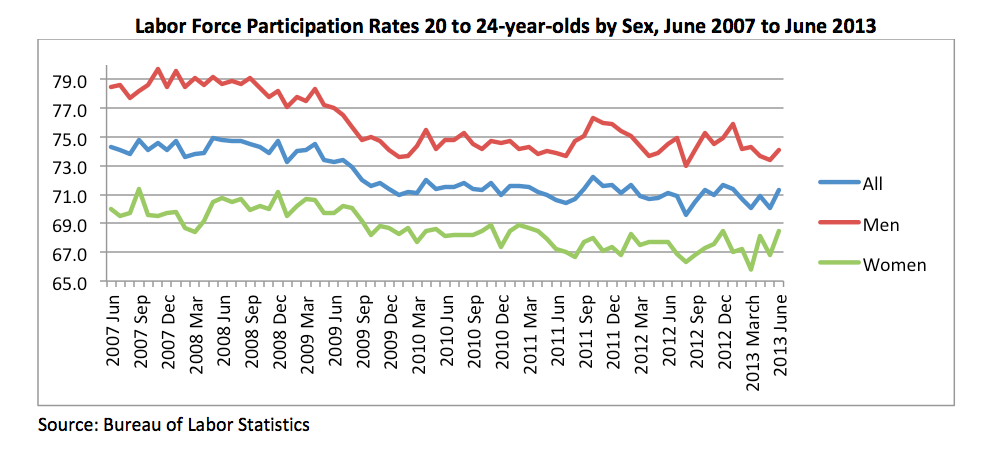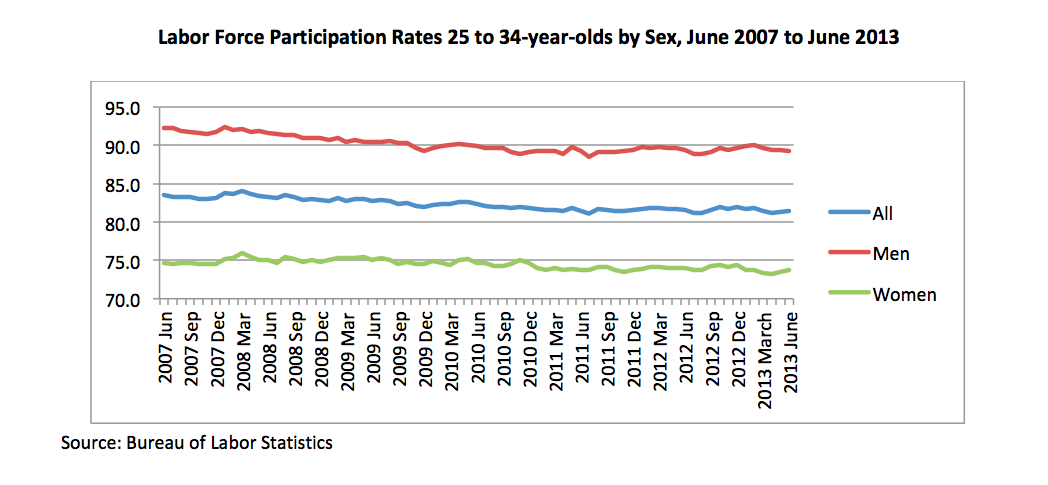
That Part-Time Food Service Summer Job of Your Dreams
For young people who look to the monthly jobs numbers for signs of hope for their future, the good news is in: that part-time, low-pay, no-benefits wait staffing job you always wanted is available for the summer. And with the job growth trend for 2013 consistently outpacing population growth, chances are you could still be a waitron come autumn. The release of the June employment numbers from the Bureau of Labor Statistics shows that people under 25 are finally getting a chance to fill some of the positions available in the sectors where they’ve traditionally had the most luck: food and drinking establishments and retail sales. And while those gains have not propelled young adults back to even the shaky labor market status they held at the end of 2012, young people are entering the labor market anyway.
The summer months typically draw workers under 25 into the labor market as students break from their studies and seasonal industries take on additional help. With a trend of solidly mediocre gains over the past few months, young people may be feeling optimistic about their chances. Since this time last year workers ages 20 to 24 have gained 234,000 jobs – that’s 10 percent of the new jobs in the economy, which accurately reflects the proportion of workers in the age category as a percentage of the labor force overall. In June, the labor force participation rate of 20 to 24-year-olds increased to 71.3 percent, with a substantial jump for women in particular. The addition of about 100,000 workers in this age group in June follows a disappointing decline in May, and puts them just above the average rate for 20 to 24-year-olds so far this year.

Of course not all of the new workers found jobs, with men in this group still having a harder time than women finding a position to settle for, so the increase in labor force participation drove up the unemployment rate for the age group despite the employment gains. The unemployment rate for 20 to 24-year-olds stands at 13.5 percent, with the unemployment rate for men climbing from 14.6 percent in May to 15 percent in June, while that for women barely budged from 11.8 percent to 11.9 percent.

The higher unemployment rate for 20 to 24-year-olds masks the real gains for the month, which propelled the employment-population ratio for the age group to 61.7 percent – its highest point since the end of last year. The employment-population ratio shows what share of the total population actually held a job; the measure eliminates the noise of a changing labor force level that may disguise employment gains in a higher unemployment rate. In June of 2007, before the Great Recession, the employment-population ratio for 20 to 24-year-olds was 68.3 percent. The 6.6 percentage point difference reveals how much further this age group has to go in order to regain anything like pre-recession normalcy, but increases in the ratio are the kind of good news that should bring young people back to the market.
Summer seasonal hiring benefits workers of all ages, but 25 to 34-year-olds do not typically see the same participation gains as their younger counterparts. In June the labor force participation rate for workers ages 25 to 34 saw a slight increase to 81.4 percent. The gain is the first news of positive participation changes in three months and returns the age group to its March 2013 level. The June aberration from the short-term decline occurred solely among women, who increased their labor force participation rate from 73.5 to 73.7 percent in June while men barely slid from 89.4 to 89.3 percent over the month. Despite the gain, the labor force participation rate for 25 to 34-year-olds remains below the annual averages for the age group, even those at the height of the official recession.

Although 25 to 34-year-olds have seen greater employment growth than the younger group over the past several years, this cohort did not benefit from the job growth in June. In fact, 25 to 34-year-olds actually lost a little ground this month, seeing their employment-population ratio decline from 75.5 percent in May to 75.2 percent in June. But workers did not leave the labor market as a result – a good sign showing some resiliency for the age group in the labor market. With lower employment and many people sticking around to look for new work, the unemployment rate for 25 to 34-year-olds increased from 7.0 percent in May to 7.6 percent in June. Women in this age group found less opportunity than men, with unemployment rates for women jumping from 7.1 percent to 7.9 percent compared to a move from 7.3 percent to 7.4 percent for men.
After the small gains in June, the size of the young adult workforce is larger than ever. The growth shows that young people have decided that it is worthwhile to keep looking for jobs, and that they’ll settle for the jobs that are available. From the past several months of labor market reports, it’s clear that these new and returning workers can expect to hang in there for a part-time, low-pay, maybe even temporary, position. According to the June report, the number of workers who wanted full-time work but couldn’t find it increased by about 4 percent last month to 8.2 million. That means that there are almost as many involuntary part-timers in the economy today as there were in June of last year. The jobs being added to the economy have been in areas that are likely to hire staff for less than full-time workdays: more than a quarter of this month’s job growth came from food and beverage establishments. When combined with other typically part-time industries, retail and temporary services, more than half of the new jobs this month are in areas that may not support a full-time schedule. They are also industries with some of the largest predicted job growth for the decade.
Over the past year, workers in the fast food and retail industries have been engaged in a series of strikes across the country to show their employers that the hours and wages in these sectors are not enough to get by. Young people looking for employment will find the fates of those movements critical to their futures as their part-time, low-wage summer jobs turn into careers.


